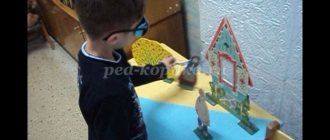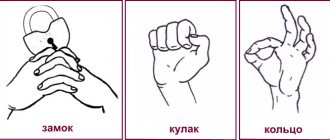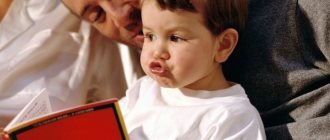Self-analysis of an individual speech therapy session
Petrova Svetlana
Self-analysis of an individual speech therapy session
Self-analysis of an individual speech therapy session
teacher-speech therapist MDOU d/s No. 45 f . 1 Petrova S. A.
The lesson was conducted with a child of the senior group with a Level III OPD conclusion. The girl was enrolled in the compensatory group in September 2020. During this period, preparatory work was carried out aimed at developing articulatory motor skills, speech breathing, phonemic perception, as well as sound production [Ш]. Currently, work is underway to automate this sound, and work continues to develop phonemic awareness. This individual lesson on automating the delivered sound occupies an important place in the system of lessons on the topic being studied , and is compiled in accordance with a long-term plan for individual correctional and developmental work.
Determining the purpose and objectives of the lesson , planning its content, methods and techniques of speech therapy intervention were carried out taking into account the age, characterological and speech characteristics of the child.
during the lesson : to develop the skill of correct pronunciation of the sound [Ш] in isolation, in syllables.
during the lesson :
Educational:
— Strengthen the correct articulation when pronouncing the sound [Ш].
-Learn to clearly pronounce the sound [Ш] in isolation, in syllables.
— Learn to give an acoustic-articulatory characteristic of the sound [Ш] according to the diagram.
Correctional and developmental:
— Develop facial muscles and articulatory motor skills through exercises: “Hippopotamus”
,
"Pancakes"
.
“Cup”
,
“Bagel”
,
“Warm breeze”
.
— Form a long oral exhalation using the visual material “Autumn Meadow”
.
— Develop phonemic awareness: recognize the sound [Ш] from a number of vowels and consonants, syllables .
— Develop fine motor skills with the help of Su-Jok therapy.
— Develop orientation on a plane
Correctional and educational:
— Develop self-control over speech .
- Cultivate the desire to speak beautifully and correctly.
The purpose of the lesson was communicated to the child, was clear to him and corresponded to the content of the lesson . The selected methods and techniques corresponded to his age and were selected taking into account his individual characteristics (state of attention, degree of fatigue, etc.)
.
Visual and verbal instructions were presented accurately and clearly. The following assistance was used: attracting attention, stimulating verbal and mental activity through instructions, using questions of various types (direct, leading, prompting, using visual supports (presentation slides)
.
The lesson was built using game-based learning technology. Stages the lessons were interconnected and sequential. The transition from one stage to another was observed.
The organizational moment helped to concentrate attention and activate the lexical material of the topic in memory. The use of a surprise moment (the appearance of a hedgehog in the autumn forest)
helped to arouse the child’s desire to work at the stage of introducing the topic
of the lesson , to increase the pupil’s internal motivation for the correctional educational process.
In order to develop facial muscles, articulatory motor skills and prepare the child’s speech apparatus, articulatory gymnastics was carried out. Particular attention was paid to proper breathing, which was necessary to develop a long-lasting, smooth air flow through the mouth. Also during the lesson the following techniques were used: to develop fine motor skills of the hands, a health-saving technology was used - Su-Jok therapy; audio recording was used to develop phonemic hearing; to teach the child to give an acoustic-articulatory characteristic of the sound [Ш], the sound analysis scheme [Ш] was used; To automate the sound [Ш], tasks were completed: isolated pronunciation of sound, pronunciation of forward and backward syllables .
Throughout the lesson, the child maintained interest, which was facilitated by the dynamics of the lesson , the appearance of new tasks on the laptop screen, and work with visual material. During the lesson, I tried to create a favorable emotional background, supplementing positive motivation for completing the task with encouragement. The child showed a positive emotional attitude and achieved his goals. The child’s speech was correct, clear, and emotional.
Conducting a self-assessment of the lesson after watching the video, the following points were highlighted:
1. After performing articulation gymnastics, I forgot to ask an additional question: “What sound did we hear?”
. This could be done since the sound was made by the child.
2. The ability to give the acoustic-articulatory characteristics of the sound [Ш] according to the diagram was not fully developed. It was necessary to consolidate this skill in the child through independent repetition , as well as at the end of the lesson .
3. In my speech I heard the words I mispronounced (happened - happened; move up, move the chair; pen, little finger, finger, mouth - hand, little finger, finger, mouth). It is necessary to monitor the quality of your own speech.
4. The lesson generally complied with sanitary and hygienic standards and health requirements, the only thing that lasted more than 15 minutes ( lesson duration was 18 minutes )
.
It is necessary to speed up the pace of the lesson and, if possible, reduce the questions asked.
I think that overall the lesson was successful and the assigned tasks were achieved. It is necessary to continue work on the ability to give an acoustic-articulatory characteristic of the sound [Ш], on the development of phonemic processes, on the automation of the sound [Ш] in words, phrases, sentences and independent speech , and also pay special attention to the differentiation of sounds [Ш] and [С] .
The positive result of the lesson confirmed the effectiveness of the methods and techniques I had chosen. To summarize, I positively assessed the child’s activities in class .
Individual lesson with a speech therapist
This type of lesson allows you to establish contact between the student and the teacher, and children’s shyness is relieved.
The structure of the plan includes:
- didactic materials;
- sensory and intellect exercises;
- motor development.
Note. The lesson lasts about 20 minutes and is held 2-3 times a week.
Structure of an individual speech therapy session
A speech therapy lesson requires certain preparation, which is carried out by the teacher.
The preparation should include:
- Formulated topic and purpose.
- Related steps.
- Grammar and vocabulary materials that gradually become more complex.
- Gaming techniques.
- Short tasks and goals formulated for children.
- Vibrant visual materials.
Note! Information should be given in an easy, positive manner.
Individual lesson
Analysis of individual speech therapy classes in kindergarten, example
Below is an example of an analysis of a speech therapist’s classes at a preschool educational institution.
Note! The goal is to automate the pronunciation of the “l” sound in syllables, words and sentences.
Tasks:
- Correction and development. Establishing a legible pronunciation of the sound “l” using specific examples, improving the perception of phonetics by ear, developing fine motor skills, coordination of movements, improving orientation in space, logical memory, visual and auditory memory.
- Correctional and educational. Teaching the child to find the main sound features in a word, answer in a complete sentence, form the genitive case, the singular number in nouns, and work according to a template.
- Correctional and educational. The ability to listen to an elder is instilled, to form a desire for classes, the ability to listen and analyze the speech of another is cultivated, and speech self-control is cultivated.
Setting the T sound
Sample report sample:
- The date of the: _.
- Time spending: _.
- Venue: _ speech therapist's office.
- Speech therapist teacher:__Ivanova I.I.
Standards for an open speech therapy lesson according to the Federal State Educational Standard and its compliance:
- Correlation of the content of the educational program with development and age. The lesson is structured consistently and logically, the selected gaming technique runs through the entire lesson and makes it more holistic.
- Teacher's behavior when receiving an incorrect answer. In case of an incorrect answer, the teacher tactfully and carefully focuses attention on the incorrect answer and gradually leads to the correct solution, without trying to correct it himself.
- Correspondence of the child’s age and development to the chosen educational program - the material is selected and presented to the child competently, in an easy way.
- Use of visual material.
- Conclusion: the lesson is intense, full-fledged, goals achieved.
Structure of speech therapy classes according to the Federal State Educational Standard in a preschool educational institution, time stages
The compilers of the Federal State Educational Standard primarily take into account the individual approach to the child and the presentation of the game.
In structure:
- development of orientation in space - 5 minutes;
- development of all types of memory - 5 minutes;
- articulation, voice, breathing - 5 minutes;
- determining the topic by children - 5 minutes;
- phonetics and syllables - 5 minutes;
- results - 2 minutes;
- assessment of work - 3 minutes.
Attention! The degree to which children assimilate the material is assessed, not the work of the teacher.
Using illustrations in the classroom
When analyzing a frontal lesson, the speech therapist must find an approach to the child, focusing his attention.
Grading Scheme:
- Topic of the lesson: differentiation of consonant sounds using the example of “s”, “z”.
- Goals: to teach to distinguish sounds in paronyms, to perceive by ear, to show kindness and responsiveness, to develop mental activity.
- Assessing the compliance of the material with the tasks and goals.
- The speech therapist's reaction to incorrect answers.
- Compliance of the specifics of the program with the age of the children.
- Use of illustrations.
- Implementation of a differential approach.
- Application of gaming techniques.
- Work on mistakes.
- The work of the child and the teacher.
- Result.
Formation of sound culture of speech in children
Note! Based on the analysis, the effectiveness of the speech therapist’s work is assessed.
“Self-analysis of correctional and developmental classes with training elements”
Self-analysis of correctional and developmental classes.
Dear colleagues, we have presented to your attention a correctional and developmental lesson with elements of training.
FULL NAME:
Koksharova Anastasia Alekseevna
Type:
correctional and developmental lesson with training elements.
Lesson form:
group.
Implementation time
: 20-25 minutes.
Number of children:
20.
Target:
Introduce children to basic emotions and ways of expressing them.
Tasks:
1. Educational:
- Expand children's understanding of the types of emotional states and facial ways of expressing them.
- Introduce the concept of “emotions”.
2. Correctional and developmental:
- Develop the emotional and sensory world of children.
- Develop children's communication skills.
- Develop cognitive processes (elements of logical thinking, memory, auditory and visual attention, imagination).
- Develop basic self-esteem skills.
3. Educational:
- To instill in first-graders a positive attitude towards themselves and others.
- Develop independence and the ability to work in a team.
Equipment:
Teacher's workstation, handouts.
Materials:
Presentation slides, cards for proofreading (with piglets), cards with islands, a poster depicting emotional states, colored pencils, markers, balloons.
Methodological support:
Course of extracurricular activities “Pathway to your “I” (based on the program of psychological classes and workbooks for schoolchildren “Pathway to your “I” (primary school) Olga Vladimirovna Khukhlaeva - Doctor of Pedagogical Sciences, Candidate of Psychological Sciences, Professor of the Moscow State Psychological and Pedagogical university).
Methods:
Practical:
developmental education (focus on ZPD), play therapy, art therapy (islands), body-oriented therapy (stress relief).
Visual:
demonstration of “Kaleidoscope of Emotions”, presentation slides, video sequences.
Verbal:
a story by a teacher-psychologist about emotions, verbal accompaniment of tasks.
Gaming:
Throughout the lesson, gaming methods were used (in the form of transformations and imaginary situations).
Ways to include children in the activity process:
intonation of speech, emotional expressiveness, taking into account individual characteristics.
To activate mental activity
search questions were used: “What do you think?”, “Why?”, “What is correct?”
Structure of a correctional and developmental lesson:
- Welcome ritual. (2 minutes.)
Exercise "Hello".
Goal: to unite children, create an atmosphere of group trust and acceptance. (For younger children, the ritual is set by an educational psychologist.)
- Warm up. (1.5 min.)
Game "Transformation into animals"
Goal: impact on the emotional state of children, their level of activity, mood for productive group activities.
- The main content of the lesson. (13-15 min.)
Priority was given to multifunctional techniques aimed simultaneously at the development of cognitive processes and the formation of social skills, and at the dynamic development of the group.
Watching the video series “My Emotions”
Goal: to form an idea of the variety of emotions and situations in which we experience such emotions.
Physical education moment.
Goal: relieve tension, switch the type of activity.
Corrective test “Piglets”
Goal: Learn to recognize the emotion of joy and develop the volume, concentration and stability of attention.
Exercise “Island of Joy and Sadness”
Goal: To distinguish one emotion from another, to show the difference.
- Reflection on the past lesson.
(2.5 min.)
Exercise “My Emotion”
(balloons) Goal: to evaluate the activity in two aspects: emotional (liked it, didn’t like it, it was good, it was bad), and semantic (why is it important, why did we do it).
- Ritual of farewell.
(1 min.)
Exercise “1,2,3,4,5 we’ll meet again soon!”
Goal: to unite children, create an atmosphere of group trust and acceptance. (For younger children, the ritual is set by an educational psychologist.)
The lesson was structured taking into account the individual psychological characteristics of the group and each child (with disabilities, disabled children).
I believe that the goal was achieved.
Thank you for your attention.
Organization of a subgroup lesson
These groups include children with identical lexical impairments.
Features of the organization:
- Attention is paid to the development of vocabulary and correct pronunciation.
- In-depth individual lessons are provided for children with serious speech impairments.
- The lesson should not last more than 30 minutes.
Note! The work of a speech therapist must be coordinated with the work of the teacher.
Analysis of a subgroup speech therapy session
Analysis of speech therapy sessions in the subgroup is carried out according to established protocols. Upon completion, an analysis of the educational program at the preschool educational institution is carried out.
The analysis includes:
- relevance of the topic to the education system;
- clarity in setting goals and objectives;
- features of the child’s speech and general behavior in class;
- characteristics of the teacher.
Additional Information! In conclusion, an assessment is made of how the group work was carried out.



